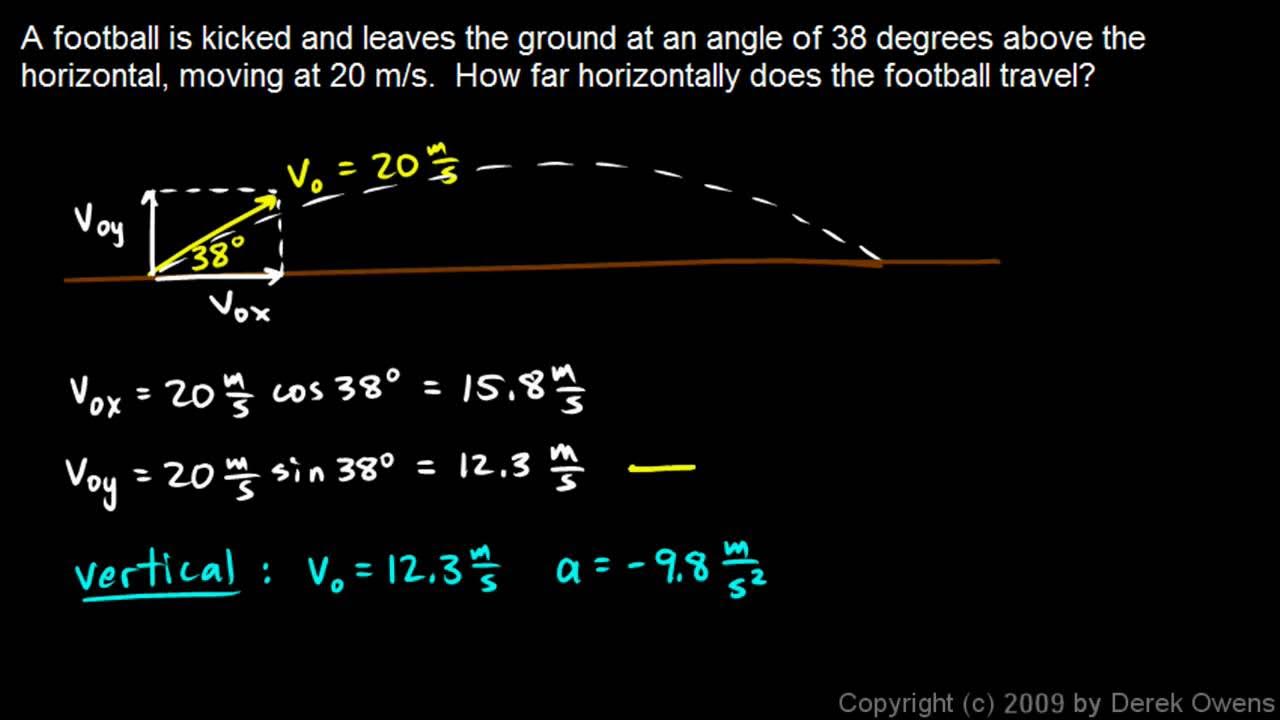Regents Physics: Angled Projectile Problem Practice
TLDRThe transcript discusses two projectile motion problems involving an initial launch at an angle. The first problem calculates the horizontal distance traveled by a human cannonball before landing, using the initial velocity's horizontal and vertical components and the time in the air. The second problem finds the maximum height reached by a ball kicked at an angle, using the vertical component of the initial velocity and the total flight time. Both problems utilize kinematic equations and trigonometry to solve for displacement and height.
Takeaways
- 🚀 The problem involves projectile motion with an object (Hermann the human cannonball) launched at an angle above the horizontal.
- 🎯 Hermann is launched from level ground at an angle of 30 degrees with an initial velocity of 26 m/s.
- 📐 The goal is to find the horizontal distance Hermann travels before returning to the ground.
- 🔢 The initial velocity is broken down into horizontal (22.5 m/s) and vertical (13 m/s) components using trigonometry.
- 🕒 The time Hermann spends in the air is calculated by analyzing the vertical motion, resulting in a total time of 2.66 seconds.
- 🏃 The horizontal distance is determined by multiplying the average horizontal velocity by the total time in the air, resulting in 59.6 meters.
- 👶 Another problem involves a ball kicked with an initial velocity of 8.5 m/s at an angle of 35 degrees above the horizontal.
- ⏱ The ball's total flight time is given as one second, and air resistance is neglected.
- 📈 The maximum height reached by the ball is calculated using the kinematic equation, yielding approximately 1.2 meters.
- 📊 The key to solving these problems is breaking down the motion into horizontal and vertical components and applying the appropriate kinematic equations.
- 📚 Trigonometry plays a crucial role in determining the initial velocity components in both horizontal and vertical directions.
Q & A
What is the initial velocity of Hermann the human cannonball?
-Hermann's initial velocity is 26 meters per second.
At what angle is Hermann launched relative to the horizontal?
-Hermann is launched at an angle of 30 degrees above the horizontal.
What is the horizontal component of Hermann's initial velocity?
-The horizontal component of Hermann's initial velocity is approximately 22.5 meters per second.
What is the vertical component of Hermann's initial velocity?
-The vertical component of Hermann's initial velocity is approximately 13 meters per second.
What is the total time Hermann spends in the air?
-Hermann spends a total of 2.66 seconds in the air.
How far does Hermann travel horizontally before hitting the ground?
-Hermann travels approximately 59.6 meters horizontally before hitting the ground.
What is the initial velocity of the ball in the second problem?
-The initial velocity of the ball is 8.5 meters per second.
What is the angle at which the ball is kicked in the second problem?
-The ball is kicked at an angle of 35 degrees with the horizontal.
What is the total flight time of the ball?
-The total flight time of the ball is one second.
What is the maximum height reached by the ball?
-The maximum height reached by the ball, neglecting air resistance, is about 1.2 meters.
How is the initial velocity vector broken down in these problems?
-The initial velocity vector is broken down into horizontal and vertical components using trigonometry, specifically cosine and sine functions.
What is the key to solving these projectile motion problems?
-The key to solving these problems is breaking down the motion into horizontal and vertical components and using the appropriate kinematic equations to analyze each component separately.
Outlines
🚀 Hermann the Human Cannonball's Horizontal Journey
This paragraph discusses the physics of projectile motion, specifically focusing on the horizontal distance traveled by Hermann the human cannonball. Hermann is launched from level ground at a 30-degree angle with an initial velocity of 26 meters per second. The key to solving the problem is understanding the horizontal and vertical components of his velocity. The horizontal component is calculated by multiplying the initial velocity by the cosine of the angle, resulting in approximately 22.5 m/s. Since air resistance is neglected, this becomes Hermann's constant horizontal velocity. The vertical component of the initial velocity is determined by multiplying the initial velocity by the sine of the angle, which is about 13 m/s. By analyzing the time Hermann takes to reach the highest point in his trajectory, we can calculate his total time in the air. Using the average horizontal velocity and total time, we can then find the horizontal distance traveled, which is approximately 59.6 meters.
🏐 Ball's Maximum Height in Projectile Motion
The second paragraph delves into another projectile motion scenario, this time with a child kicking a ball at an initial velocity of 8.5 m/s at a 35-degree angle to the horizontal. The main focus here is to find the maximum height reached by the ball during its flight, with air resistance being neglected. The ball's initial vertical velocity is given as 4.9 m/s, and the total flight time is one second. To find the maximum height, the problem is approached by analyzing the vertical motion, using the kinematic equation that relates final velocity (which is zero at the peak), initial velocity, and displacement with acceleration due to gravity. By rearranging the equation and solving for displacement, the maximum height is calculated to be approximately 1.2 meters. The key takeaway is the importance of breaking down the initial velocity into its vertical and horizontal components and focusing on the relevant motion (in this case, the vertical) to solve the problem.
Mindmap
Keywords
💡Projectile Motion
💡Initial Velocity
💡Angle of Launch
💡Horizontal and Vertical Components
💡Acceleration due to Gravity
💡Time of Flight
💡Trigonometry
💡Kinematic Equations
💡Maximum Height
💡Horizontal Distance
💡Air Resistance
Highlights
Projectile motion problems are discussed, specifically focusing on the horizontal and vertical components of the motion.
Hermann the human cannonball is used as an example to illustrate the concepts of projectile motion.
Hermann is launched at a 30-degree angle above the horizontal with an initial velocity of 26 meters per second.
The problem-solving approach involves breaking down the initial velocity into its horizontal and vertical components using trigonometry.
The horizontal component of Hermann's velocity is calculated to be approximately 22.5 meters per second.
The vertical component of the initial velocity is found to be about 13 meters per second.
Hermann's total time in the air is determined to be 2.66 seconds.
Using the average horizontal velocity and total time, Hermann's horizontal distance is calculated to be approximately 59.6 meters.
The second problem involves a ball kicked at an angle above the horizontal with a given initial velocity and flight time.
The ball's initial vertical velocity is given as 4.9 m/s, and the flight time is one second.
The maximum height reached by the ball is calculated by analyzing the vertical motion and using the kinematic equation.
The maximum height is found to be approximately 1.2 meters, neglecting air resistance.
The importance of understanding the horizontal and vertical separation in analyzing projectile motion is emphasized.
The use of trigonometry to break down the initial velocity vector into components is highlighted as a crucial step in solving these problems.
The practical application of these concepts is demonstrated through the use of real-world examples, such as a human cannonball and a kicked ball.
The process of solving these problems is outlined, providing a clear methodology for tackling projectile motion scenarios.
Transcripts
Browse More Related Video
5.0 / 5 (0 votes)
Thanks for rating:





